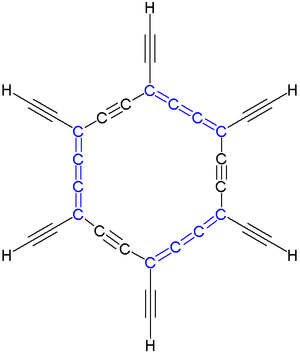In organic chemistry, a carbo-mer (often carbo-mer or carbomer) is an expanded molecule obtained by insertion of C2 units into a given molecule. Carbo-mers differ from their templates in size but not in symmetry when each C–C single bond is replaced by an alkyne bond C-C≡C-C, each C=C double bond is replaced by an allene bond C=C=C=C, and each C≡C triple bond is replaced by C≡C-C≡C. The size of the carbo-mer continues to increase when more C2 units are inserted, so carbo-mers are also called carbo-molecules, where "n" is the number of acetylene or allene groups in an n-expansion unit. This concept, devised by Rémi Chauvin in 1995, is aimed at introducing new chemical properties for existing chemical motifs.
Two distinct expansions of benzene can be called carbo-benzene (C18H6):
One (above right) expands each C-H bond to C-C≡C-H, making hexaethynylbenzene, a substituted benzene derivative.
One (above left) expands each C=C and C≡C bond of the benzene core, making 1,2,4,5,7,8,10,11,13,14,16,17-dodecadehydroannulene. An analog of this molecule, with the hydrogen atoms replaced by phenyl groups, 3,6,9,12,15,18-hexaphenyl-1,2,4,5,7,8,10,11,13,14,16,17-dodecadehydroannulene, is stable. Its proton NMR spectrum shows that the phenyl protons are shifted downfield compared to a proton position in benzene itself (chemical shift position for the ortho proton is 9.49 ppm), suggesting the presence of a diamagnetic ring current and thus aromaticity. The final step in its organic synthesis is reaction of the triol with stannous chloride and hydrochloric acid in diethyl ether:
With both core and periphery expanded, the total carbo-mer of benzene (C30H6) only exists in silico (computer simulation).
Calculations predict a planar D6h structure with bond lengths similar to the other two carbobenzenes. Its non-planar isomer is called "hexaethynyl-carbo-trannulene" - a pun on the all-cis annulenes - and resembles a cyclohexane ring. This hypothetical molecule is predicted to be more energetic by 65 kcal/mol.
References
- Carbomers. I. A general concept of expanded molecules Remi Chauvin Tetrahedron Letters Volume 36, Issue 3, 16 January 1995, Pages 397-400 doi:10.1016/0040-4039(94)02275-G
- Hexaethynylbenzene Rainer Diercks, James C. Armstrong, Roland Boese, K. Peter C. Vollhardt. Hexaethynylbenzene. Angewandte Chemie International. 1986; 25(3):268-269. doi:10.1002/anie.198602681
- Synthesis of the first 3,6,9,15,18,18-hexa-substituted-1,2,4,5,7,8,10,11,13,14,16,17-dodecadehydroannulenes with D6h-symmetry Yoshiyuki Kuwatani, Naoto Watanabe and Ikuo Ueda Tetrahedron Letters Volume 36, Issue 1, 2 January 1995, Pages 119-122 doi:10.1016/0040-4039(94)02181-A
- Total carbo-Mer of Benzene, Its carbo-Trannulene Form, and the Zigzag Nanotube Thereof Christine Lepetit, Chunhai Zou, and Remi Chauvin J. Org. Chem.; 2006; 71(17) pp 6317 - 6324; (Article) doi:10.1021/jo052551j


